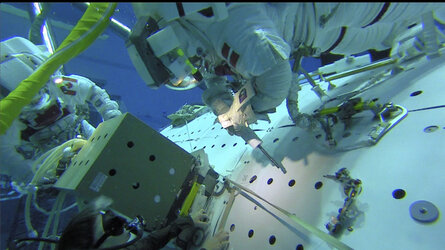Accept all cookies Accept only essential cookies See our Cookie Notice

About ESA
The European Space Agency (ESA) is Europe’s gateway to space. Its mission is to shape the development of Europe’s space capability and ensure that investment in space continues to deliver benefits to the citizens of Europe and the world.
Highlights
ESA - United space in Europe
This is ESA ESA facts Member States & Cooperating States Funding Director General Top management For Member State Delegations European vision European Space Policy ESA & EU Space Councils Responsibility & Sustainability Annual Report Calendar of meetings Corporate newsEstablishments & sites
ESA Headquarters ESA ESTEC ESA ESOC ESA ESRIN ESA EAC ESA ESAC Europe's Spaceport ESA ESEC ESA ECSAT Brussels Office Washington OfficeWorking with ESA
Business with ESA ESA Commercialisation Gateway Law at ESA Careers Cyber resilience at ESA IT at ESA Newsroom Partnerships Merchandising Licence Education Open Space Innovation Platform Integrity and Reporting Administrative Tribunal Health and SafetyMore about ESA
History ESA Historical Archives Exhibitions Publications Art & Culture ESA Merchandise Kids Diversity ESA Brand CentreLatest
Space in Member States
Find out more about space activities in our 23 Member States, and understand how ESA works together with their national agencies, institutions and organisations.
Science & Exploration
Exploring our Solar System and unlocking the secrets of the Universe
Go to topicAstronauts
Missions
Juice Euclid Webb Solar Orbiter BepiColombo Gaia ExoMars Cheops Exoplanet missions More missionsActivities
International Space Station Orion service module Gateway Concordia Caves & Pangaea BenefitsLatest
Space Safety
Protecting life and infrastructure on Earth and in orbit
Go to topicAsteroids
Asteroids and Planetary Defence Asteroid danger explained Flyeye telescope: asteroid detection Hera mission: asteroid deflection Near-Earth Object Coordination CentreSpace junk
About space debris Space debris by the numbers Space Environment Report In space refuelling, refurbishing and removingSafety from space
Clean Space ecodesign Zero Debris Technologies Space for Earth Supporting Sustainable DevelopmentLatest
Applications
Using space to benefit citizens and meet future challenges on Earth
Go to topicObserving the Earth
Observing the Earth Future EO Copernicus Meteorology Space for our climate Satellite missionsCommercialisation
ESA Commercialisation Gateway Open Space Innovation Platform Business Incubation ESA Space SolutionsLatest
Enabling & Support
Making space accessible and developing the technologies for the future
Go to topicBuilding missions
Space Engineering and Technology Test centre Laboratories Concurrent Design Facility Preparing for the future Shaping the Future Discovery and Preparation Advanced Concepts TeamSpace transportation
Space Transportation Ariane Vega Space Rider Future space transportation Boost! Europe's Spaceport Launches from Europe's Spaceport from 2012Latest

Pool preps
Thank you for liking
You have already liked this page, you can only like it once!
Prepping for a spacewalk typically means diving underwater to rehearse and fine-tune operations.
In 2016, ESA astronaut Alexander Gerst performed such an underwater rehearsal for the Colka high speed radio, the brown box imaged above, that will be installed this month on the International Space Station.
NASA astronauts Mike Hopkins and Victor Glover will integrate the small fridge-sized device outside the European Columbus module during a spacewalk scheduled this year. ESA astronaut Andreas Mogensen will be at NASA’s mission control directing the spacewalkers as Capcom. The Columbus Ka-band terminal, nicknamed ‘Colka’, will enable faster communication with Europe.
Orbiting the planet every 90 minutes means the Space Station is constantly making and breaking short links with ground stations on Earth as it passes over them at a height of 400 km.
With Colka, a European telecommunications satellite in geostationary orbit can pick up data sent from the Columbus module. This satellite is part of the European Data Relay System and will be able to directly relay the signals from Columbus to European soil via a ground station in Harwell, in the UK.
The current data relay system routes via USA, which results in longer data transfer times. The Colka upgrade will ensure faster communications between Columbus and Europe, speeds of up to 50 Mbit/s for downlink and up to 2 Mbit/s for uplink. This will allow astronauts and researchers to benefit from a direct link with Europe at home broadband speeds – delivering a whole family’s worth of video streaming and data for science and communications.
Colka will be installed just weeks after the announcement that Europe will start building a communications module in support of the Gateway, the next spaceship to be assembled and operated in the vicinity of the Moon by International Space Station partners. The ESPRIT High-speed Lunar Communication System will be launched on NASA’s Gateway living quarters, in 2024.
As humankind ventures farther from Earth and goes forward to the Moon, a robust communications infrastructure is necessary for the lunar economy and to return knowledge and benefits to Earth. ESA is working on this with the Moonlight project, a system for lunar telecommunications and navigation to reduce design complexity, liberating missions to concentrate on their core activities.
ColKa was designed and built by British and Italian companies, using products from Belgium, Canada, France, Germany and Norway, some of which have been qualified under the ESA’s programme of Advanced Research in Telecommunications Systems (ARTES).
-
CREDIT
NASA EVA NBL -
LICENCE
ESA Standard Licence

Space Station communications infographic

Bartoloemo and Colka during spacewalk

Showtime for ColKa

Space antenna















 Germany
Germany
 Austria
Austria
 Belgium
Belgium
 Denmark
Denmark
 Spain
Spain
 Estonia
Estonia
 Finland
Finland
 France
France
 Greece
Greece
 Hungary
Hungary
 Ireland
Ireland
 Italy
Italy
 Luxembourg
Luxembourg
 Norway
Norway
 The Netherlands
The Netherlands
 Poland
Poland
 Portugal
Portugal
 Czechia
Czechia
 Romania
Romania
 United Kingdom
United Kingdom
 Slovenia
Slovenia
 Sweden
Sweden
 Switzerland
Switzerland
























